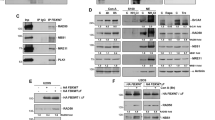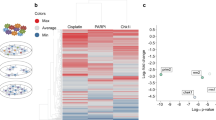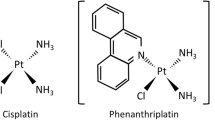Abstract
The goal of this study was to identify changes in mRNA levels in tumour cells after a toxic exposure to cisplatin (IC99dose). Using suppression-subtractive hybridization (SSH) 2 cDNA libraries were created, an UP library (202 cDNA fragments) and a DOWN library (153 cDNA fragments). Using reversed Northern hybridization 16 and 30 fragments were truly differentially expressed in the UP and DOWN libraries, respectively. Most prominent in the UP library were the mitochondrial and injury response clusters and in the DOWN library the cytoskeletal, protein synthesis and signalling clusters. These distinct clusters potentially represent an expression profile of the cisplatin-induced cellular injury response. © 2001 Cancer Research Campaign http://www.bjcancer.com
Similar content being viewed by others
Article PDF
Change history
16 November 2011
This paper was modified 12 months after initial publication to switch to Creative Commons licence terms, as noted at publication
References
Balla G, Jacob HS, Balla J, Rosenberg M, Nath K, Apple F, Eaton JW and Vercellotti GM (1992) Ferritin: a cytoprotective antioxidant strategem of endothelium. J Biol Chem 267: 18148–18153
Brancolini C, Lazarevic D, Rodriguez J and Schneider C (1997) Dismantling cell–cell contacts during apoptosis is coupled to a caspase-dependent proteolytic cleavage of beta-catenin. J Cell Biol 139: 759–771
Corda Y, Job C, Anin MF, Leng M and Job D (1991) Transcription by eucaryotic and procaryotic RNA polymerases of DNA modified at a d(GG) or a d(AG) site by the antitumor drug cis-diamminedichloroplatinum(II). Biochemistry 30: 222–230
Darnell J, Lodish H and Baltimore D (1990) Organelle biogenesis: the nucleus, chloroplast and mitochondria. In Molecular cell biology, J Darnell, HLD Baltimore (ed) pp. 686–699, Scientific American Books, Inc: New York, NY
Diatchenko L, Lau YF, Campbell AP, Chenchik A, Moqadam F, Huang B, Lukyanov S, Lukyanov K, Gurskaya N, Sverdlov ED and Siebert PD (1996) Suppression subtractive hybridization: a method for generating differentially regulated or tissue-specific cDNA probes and libraries. Proc Natl Acad Sci USA 93: 6025–6030
Dieudonne SC, Kerr JM, Xu T, Sommer B, DeRubeis AR, Kuznetsov SA, Kim IS, Gehron Robey P and Young MF (1999) Differential display of human marrow stromal cells reveals unique mRNA expression patterns in response to dexamethasone. J Cell Biochem 76: 231–243
Duttaroy A, Bourbeau D, Wang XL and Wang E (1998) Apoptosis rate can be accelerated or decelerated by overexpression or reduction of the level of elongation factor-1 alpha. Exp Cell Res 238: 168–176
Eastman A (1990) Activation of programmed cell death by anticancer agents: cisplatin as a model system. Cancer Cells 2: 275–280
Fink D, Nebel S, Aebi S, Zheng H, Cenni B, Nehme A, Christen RD and Howell SB (1996) The role of DNA mismatch repair in platinum drug resistance. Cancer Res 56: 4881–4886
Grenman R, Carey TE, McClatchey KD, Wagner JG, Pekkola-Heino K, Schwartz DR, Wolf GT, Lacivita LP, Ho L and Baker SR (1991) In vitro radiation resistance among cell lines established from patients with squamous cell carcinoma of the head and neck. Cancer 67: 2741–2747
Howell SB, Gately DP, Christen RD and Los G (1996) The cisplatin-induced cellular injury response. Proceedings of the ISPCC, in “Platinum and other Metal coordination compounds in Cancer Chemotherapy 2”, Plenum Press: New York 269–282
Huff T, Ballweber E, Humeny A, Bonk T, Becker C, Muller CS, Mannherz HG and Hannappel E (1999) Thymosin beta(4) serves as a glutaminyl substrate of transglutaminase. Labeling with fluorescent dansylcadaverine does not abolish interaction with G-actin. FEBS Lett 464: 14–20
Itoh H and Tashima Y (1991) The stress (heat shock) proteins. Int J Biochem 23: 1185–1191
Johnsson A, Zeelenberg I, Min Y, Hilinski J, Berry C, Howell SB and Los G (2000) Identification of genes differentially expressed in association with acquired cisplatin resistance [In Process Citation]. Br J Cancer 83: 1047–1054
Jordan P and Carmo-Fonseca M (1998) Cisplatin inhibits synthesis of ribosomal RNA in vivo. Nucleic Acids Res 26: 2831–2836
Kato MV (1999) The mechanisms of death of an erythroleukemic cell line by p53: involvement of the microtubule and mitochondria. Leuk Lymphoma 33: 181–186
Koller HT, Klade T, Ellinger A and Breitenbach M (1996) The yeast growth control gene GRC5 is highly homologous to the mammalian putative tumor suppressor gene QM. Yeast 12: 53–65
Kremerskothen J, Nettermann M, op de Bekke A, Bachmann M and Brosisus J (1998) Identification of human autoantigen La/SS-B as BC1/BC200 RNA-binding protein. DNA Cell Biol 17: 751–759
Kuang WW, Thompson DA, Hoch RV and Weigel RJ (1998) Differential screening and suppression subtractive hybridization identified genes differentially expressed in an estrogen receptor-positive breast carcinoma cell line. Nucleic Acids Res 26: 1116–1123
Lage H, Christmann M, Kern MA, Dietel M, Pick M, Kaina B and Schadendorf D (1999) Expression of DNA repair proteins hMSH2, hMSH6, hMLH1, O6-methylguanine-DNA methyltransferase and N-methylpurine-DNA glycosylase in melanoma cells with acquired drug resistance. Int J Cancer 80: 744–750
Oliner JD, Pietenpol JA, Thiagalingam S, Gyuris J, Kinzler KW and Vogelstein B (1993) Oncoprotein MDM2 conceals the activation domain of tumour suppressor p53. Nature 362: 857–860
Pinto AL and Lippard SJ (1985) Sequence-dependent termination of in vitro DNA synthesis by cis- and trans-diamminedichloroplatinum (II). Proc Natl Acad Sci USA 82: 4616–4619
Pontremoli S and Grazi E (1968) Gluconeogenesis. In Carbohydrate Metabolism and its disorders, Dickens F, Randle PJ, Whelan WJ (ed), Vol. 1: 259–295, Academic Press
Satoh K, Wakui H, Komatsuda A, Nakamoto Y, Miura AB, Itoh H and Tashima Y (1994) Induction and altered localization of 90-kDa heat-shock protein in rat kidneys with cisplatin-induced acute renal failure. Ren Fail 16: 313–323
Tanabe M, Sasai N, Nagata K, Liu XD, Liu PC, Thiele DJ and Nakai A (1999) The mammalian HSF4 gene generates both an activator and a repressor of heat shock genes by alternative splicing. J Biol Chem 274: 27845–27856
Tiao G, Hobler S, Wang JJ, Meyer TA, Luchette FA, Fischer JE and Hasselgren PO (1997) Sepsis is associated with increased mRNAs of the ubiquitin-proteasome proteolytic pathway in human skeletal muscle. J Clin Invest 99: 163–168
Toney JH, Donahue BA, Kellett PJ, Bruhn SL, Essigmann JM and Lippard SJ (1989) Isolation of cDNAs encoding a human protein that binds selectively to DNA modified by the anticancer drug cis-diamminedichloroplatinum(II) [published erratum appears in Proc Natl Acad Sci USA 1990 Feb; 87(4): 1625]. Proc Natl Acad Sci USA 86: 8328–8332
Zhang L, Zhou W, Velculescu VE, Kern SE, Hruban RH, Hamilton SR, Vogelstein B and Kinzler KW (1997) Gene expression profiles in normal and cancer cells. Science 276: 1268–1272
Author information
Authors and Affiliations
Rights and permissions
From twelve months after its original publication, this work is licensed under the Creative Commons Attribution-NonCommercial-Share Alike 3.0 Unported License. To view a copy of this license, visit http://creativecommons.org/licenses/by-nc-sa/3.0/
About this article
Cite this article
Johnsson, A., Byrne, P., Bruin, R. et al. Identification of gene clusters differentially expressed during the cellular injury responses (CIR) to cisplatin. Br J Cancer 85, 1206–1210 (2001). https://doi.org/10.1054/bjoc.2001.2080
Received:
Revised:
Accepted:
Published:
Issue date:
DOI: https://doi.org/10.1054/bjoc.2001.2080
Keywords
This article is cited by
-
cDNA microarray-based identification of genes and pathways associated with oxaliplatin resistance
Cancer Chemotherapy and Pharmacology (2005)



